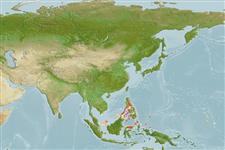Actinopterygii (ray-finned fishes) >
Gobiesociformes (Clingfishes) >
Gobiesocidae (Clingfishes and singleslits) > Gobiesocinae
Etymology: Lepadichthys: Greek, lepas, -ados = limpet + Greek, ichtys = fish (Ref. 45335); springeri: Named for Victor G. Springer.. More on author: Briggs.
Environment / Climate / Range
Ecology
Marine; reef-associated; depth range 1 - 10 m (Ref. 40788). Tropical, preferred ?
Western Central Pacific: Philippines.
Size / Weight / Age
Maturity: Lm ? range ? - ? cm
Max length : 2.6 cm SL male/unsexed; (Ref. 40788)
Short description
Morphology | Morphometrics
Dorsal
soft rays
(total): 12-13;
Anal
soft rays: 10 - 11. Dorsal and anal fins confluent with caudal; both of medium length. Origin of anal fin much closer to rear margin of the disc. Upper attachment of gill membrane opposite 8th (or ninth) pectoral ray. Postdorsal-caudal distance 4-4.5 in dorsal length. Caudal fin rays 7-8 (Ref. 40788).
Occurs in coral reefs at 1-10 m deep (Ref. 90102). Minimum depth of 1 m reported from Ref. 90102.
Life cycle and mating behavior
Maturity | Reproduction | Spawning | Eggs | Fecundity | Larvae
Oviparous, distinct pairing during breeding (Ref. 205).
Briggs, J.C., 2001. New species of Lepadichthys from the Philippine Islands. Copeia 2001(2):499-500. (Ref. 40788)
IUCN Red List Status (Ref. 115185)
CITES (Ref. 94142)
Not Evaluated
Threat to humans
Harmless
Human uses
More information
Age/SizeGrowthLength-weightLength-lengthLength-frequenciesMorphometricsMorphologyLarvaeLarval dynamicsRecruitmentAbundance
ReferencesAquacultureAquaculture profileStrainsGeneticsAllele frequenciesHeritabilityDiseasesProcessingMass conversion
Tools
Special reports
Download XML
Internet sources
Estimates of some properties based on models
Phylogenetic diversity index (Ref.
82805): PD
50 = 0.5005 [Uniqueness, from 0.5 = low to 2.0 = high].
Bayesian length-weight: a=0.00550 (0.00238 - 0.01266), b=3.11 (2.91 - 3.31), in cm Total Length, based on LWR estimates for this (Sub)family-body shape (Ref.
93245).
Trophic Level (Ref.
69278): 3.3 ±0.2 se; Based on size and trophs of closest relatives
Resilience (Ref.
69278): High, minimum population doubling time less than 15 months (Preliminary K or Fecundity.).
Vulnerability (Ref.
59153): Low vulnerability (21 of 100) .
